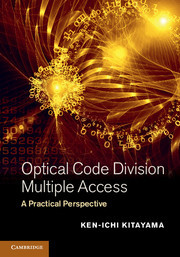Description
Optical Code Division Multiple Access
A Practical Perspective
Author: Kitayama Ken-ichi
A self-contained guide to OCDMA for Next-Generation FTTH systems, from the fundamentals to cutting-edge research and practical perspectives.
Language: English
Subject for Optical Code Division Multiple Access:
Approximative price 149.32 €
In Print (Delivery period: 14 days).
Add to cart
Publication date: 04-2014
357 p. · 18.2x25.3 cm · Hardback
357 p. · 18.2x25.3 cm · Hardback
Description
/li>Contents
/li>Biography
/li>
A comprehensive guide to optical fiber communications, from the basic principles to the latest developments in OCDMA for Next-Generation Fiber-to-the-Home (FTTH) systems. Part I starts off with the fundamentals of light propagation in optical fibers, including multiple access protocols, and their enabling techniques. Part II is dedicated to the practical perspectives of Next-Generation Fiber-to-the-Home (FTTH) technology. It covers the key building blocks of OCDMA, devices such as optical encoders and decoders, signal impairments due to noise, and data confidentiality, a unique property of OCDMA. This is followed by hybrid system architectures with TDM and WDM and practical aspects such as system cost, energy efficiency and long-reach PONs. Featuring the latest research, with cutting-edge coverage of system design, optical implementations, and experimental demonstrations in test beds, this text is ideal for students, researchers and practitioners in the industry seeking to obtain an up-to-date understanding of optical communication networks.
1. Introduction; Part I: 2. Optical multiple access systems; 3. Light propagation in optical fiber; 4. Fundamental of transmission systems; 5. Enabling techniques; Part II: 6. OCDMA principles; 7. Optical encoding and decoding; 8. Data confidentiality; 9. Testbeds of OCDMA systems and its hybrid systems; 10. Practical aspects.
Ken-ichi Kitayama has been Professor in the Division of Electrical, Electronic and Information Engineering at Osaka University, Japan, since 1999. He has published over 270 papers in refereed journals and holds more than 40 patents. He is a Fellow of the IEEE and a Fellow of IEICE, Japan.
© 2024 LAVOISIER S.A.S.




